

Ashim Puroihit
Pursuing MS in Information Systems (Spring 2014)
IS677 Group 10. CIA Unveils Five-Year Strategy Plan. CIA 2015, released this week, seeks to ensure the agency remains in step with current national security challenges, such as cyber threats The CIA has made investing in technology to prevent and fight cyber threats as one of its three main priorities in a five-year strategic plan unveiled this week.

The move is in line with a government-wide ramp-up in cybersecurity efforts across all agencies that have responsibility for protecting critical infrastructure in the United States, such as the Department of Homeland Security and the National Security Agency. CIA 2015, released this week, is a three-pillar blueprint for the agency's next five years.
FBI Org Chart. Advantages of a Flat Organizational Structure. If you operate a business, you may wonder about the advantages of a flat organizational structure.

A flat organizational structure, as its name suggests, has fewer levels of management between managers, executives, and employees. It is also referred to as horizontal organization. Federal Bureau of Investigation. Central Intelligence Agency. The entrance of the CIA New Headquarters Building (NHB) of the George Bush Center for Intelligence.
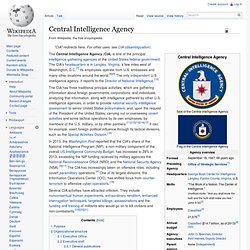
The Central Intelligence Agency (CIA) is one of the principal intelligence-gathering agencies of the United States federal government. The CIA's headquarters is in Langley, Virginia, a few miles west of Washington, D.C.[7] Its employees operate from U.S. embassies and many other locations around the world.[8][9] The only independent U.S. intelligence agency, it reports to the Director of National Intelligence.[10] Several CIA activities have attracted criticism. They include nonconsentual human experiments, extraordinary rendition, enhanced interrogation techniques, targeted killings, assassinations and the funding and training of militants who would go on to kill civilians and non-combatants.[19][20][21] Purpose According to its fiscal 2013 budget, the CIA has five priorities:[4]
CIA vs FBI. The FBI's Upgrade That Wasn't. As far as Zalmai Azmi was concerned, the FBI's technological revolution was only weeks away.
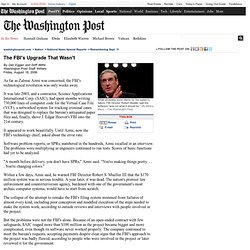
It was late 2003, and a contractor, Science Applications International Corp. (SAIC), had spent months writing 730,000 lines of computer code for the Virtual Case File (VCF), a networked system for tracking criminal cases that was designed to replace the bureau's antiquated paper files and, finally, shove J. Edgar Hoover's FBI into the 21st century. It appeared to work beautifully. Until Azmi, now the FBI's technology chief, asked about the error rate. Software problem reports, or SPRs, numbered in the hundreds, Azmi recalled in an interview.
"A month before delivery, you don't have SPRs," Azmi said. Within a few days, Azmi said, he warned FBI Director Robert S. Boundless. Network Organizational Structure. What is a matrix organization structure? A definition. Definition of a matrix organization structure A matrix organization structure is usually defined as one where there are multiple reporting lines – that is, people have more than one formal boss.

This may incorporate solid lines (direct strong reporting) and dotted lines (a weaker reporting relationship, but still indicating some formal level of ‘right’ to the individual’s time) or it may mean multiple solid lines to more than one boss. HowStuffWorks "Structure of the FBI " The FBI is part of the U.S.
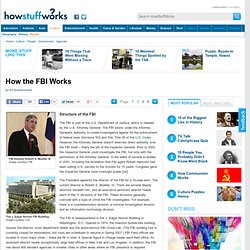
Department of Justice, which is headed by the U.S. Attorney General. Hierarchical organization. Members of hierarchical organizational structures chiefly communicate with their immediate superior and with their immediate subordinates.
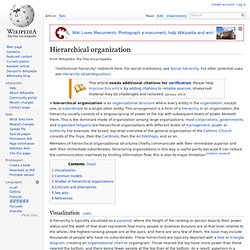
Structuring organizations in this way is useful partly because it can reduce the communication overhead by limiting information flow; this is also its major limitation. [citation needed] Visualization[edit] Common models[edit] Flat organization. A flat organization (also known as horizontal organization or delayering) is an organization that has an organizational structure with few or no levels of middle management between staff and executives.
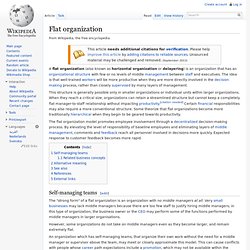
The idea is that well-trained workers will be more productive when they are more directly involved in the decision making process, rather than closely supervised by many layers of management. The flat organization model promotes employee involvement through a decentralized decision-making process. By elevating the level of responsibility of baseline employees and eliminating layers of middle management, comments and feedback reach all personnel involved in decisions more quickly. Expected response to customer feedback becomes more rapid. Self-managing teams[edit] Federal Bureau of Investigation Organizational Culture. This essay will discuss the organizational culture of the Federal Bureau of Investigation.
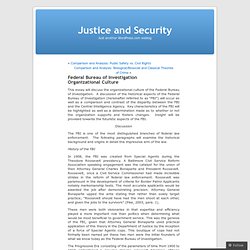
A discussion of the historical aspects of the Federal Bureau of Investigation (hereinafter referred to as “FBI”) will occur as well as a comparison and contrast of the disparity between the FBI and the Central Intelligence Agency. Key characteristics of the FBI will be highlighted as well as a determination made as to whether or not the organization supports and fosters changes. Insight will be provided towards the futuristic aspects of the FBI. Discussion. The Failure Of The FBI’s Virtual Case File Project. Between 2001 and 2005, the FBI’s Virtual Case File project failed.

The Virtual Case File project was part of a larger initiative called Trilogy. Costs overran by 89% or just over $200M. A project that should have taken 3 years, failed after 4 years with requirements still not met. Virtual Case File. Virtual Case File (or VCF) was a software application developed by the United States Federal Bureau of Investigation (FBI) between 2000 and 2005. The project was officially abandoned in April 2005, while still in development stage and cost the federal government nearly $170 million. In 2006, the Washington Post wrote "In a 318-page report, completed in January 2005 and obtained by The Post under the Freedom of Information Act, [the Aerospace Corporation] said the SAIC software was incomplete, inadequate and so poorly designed that it would be essentially unusable under real-world conditions.
Even in rudimentary tests, the system did not comply with basic requirements, the report said. It did not include network-management or archiving systems—a failing that would put crucial law enforcement and national security data at risk"[1]